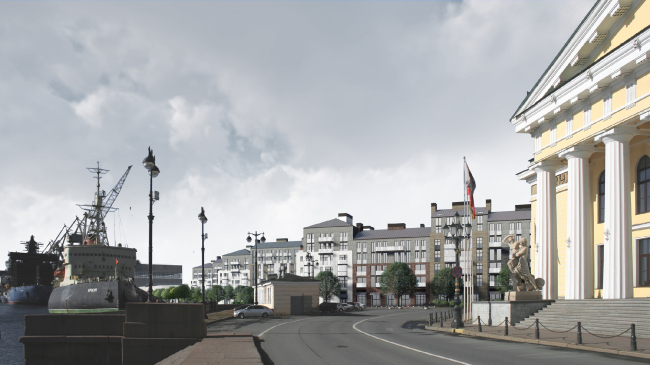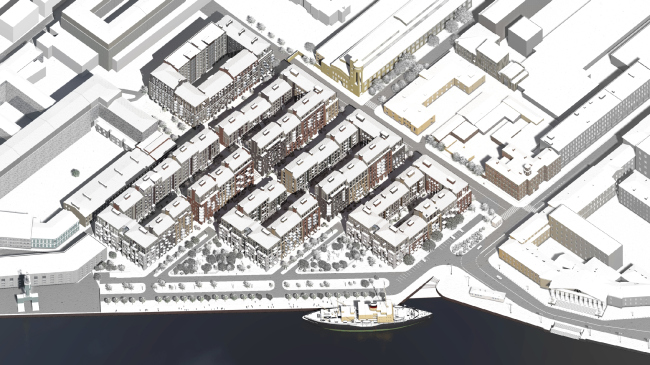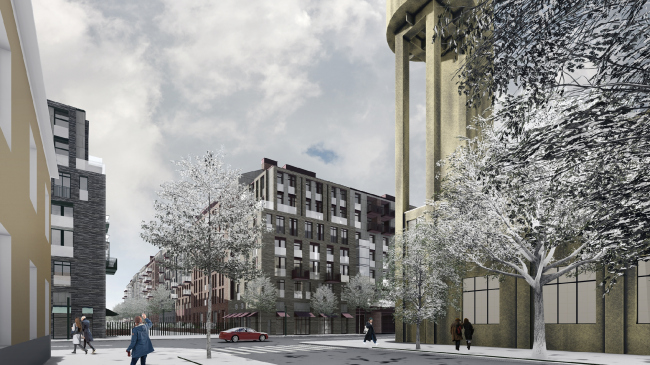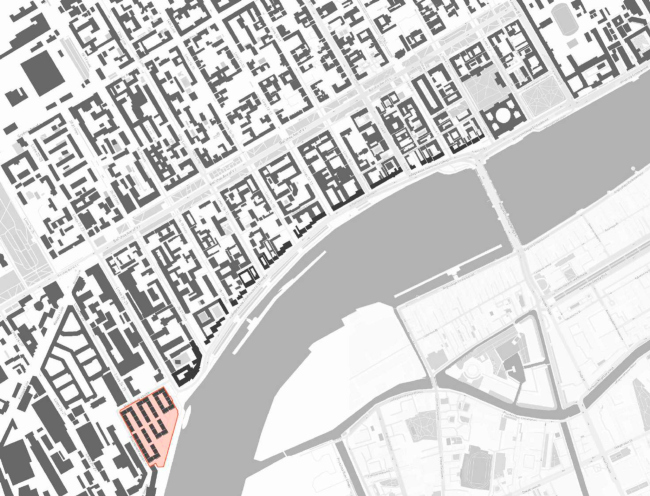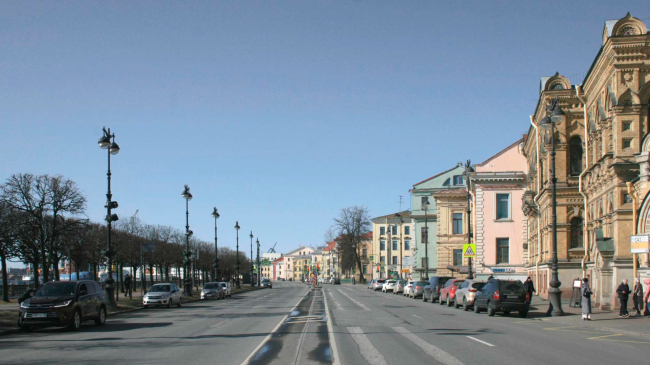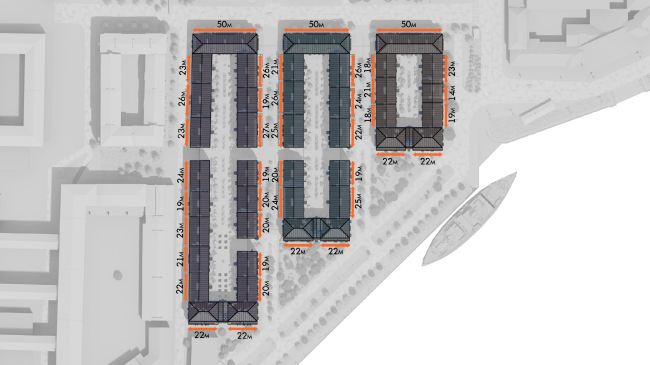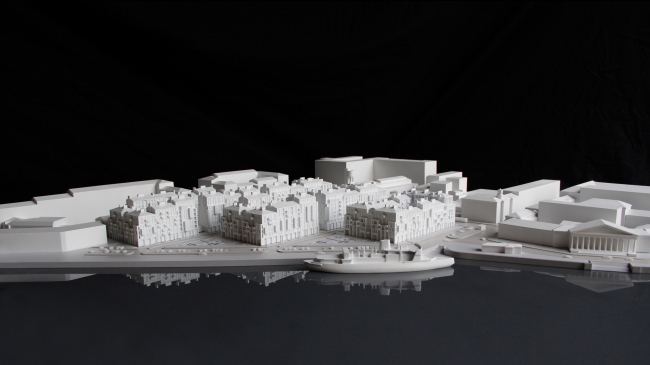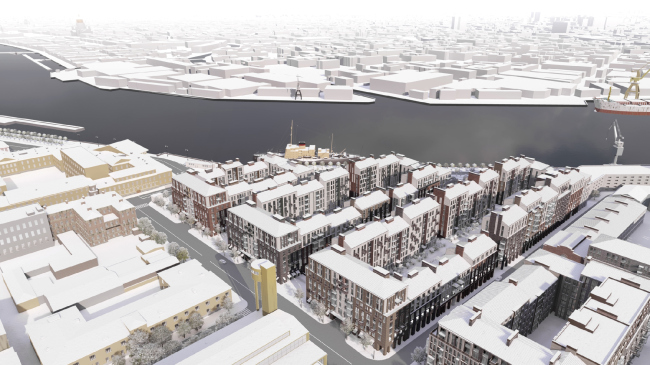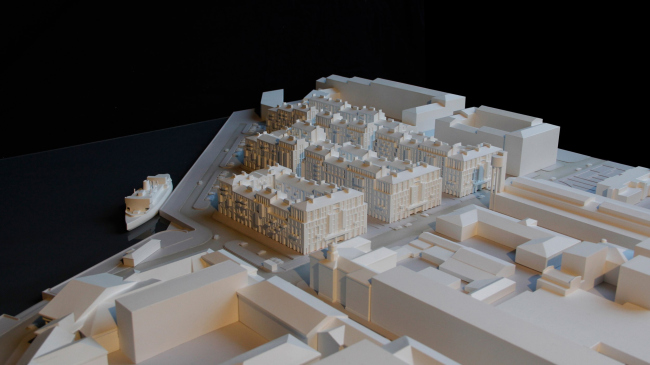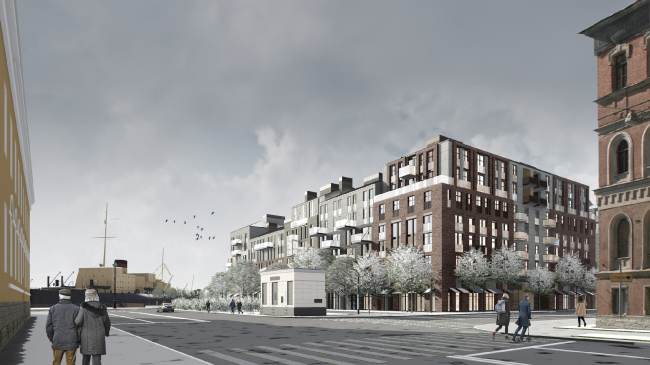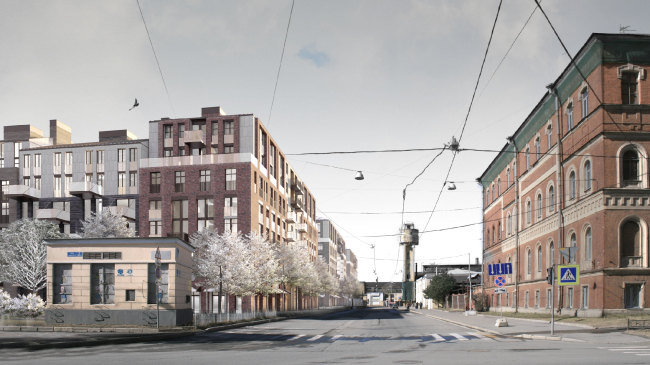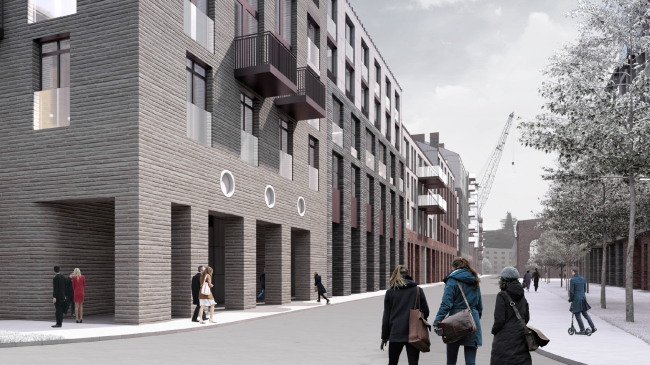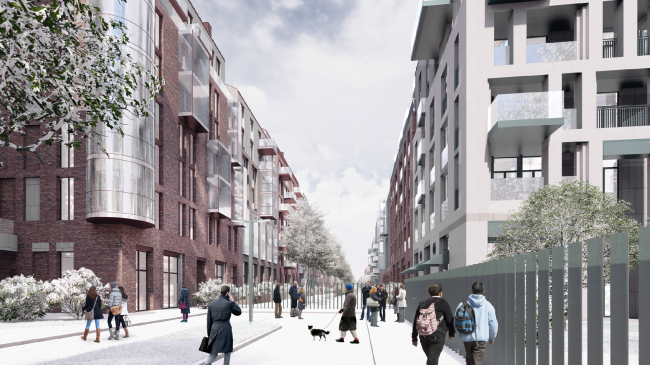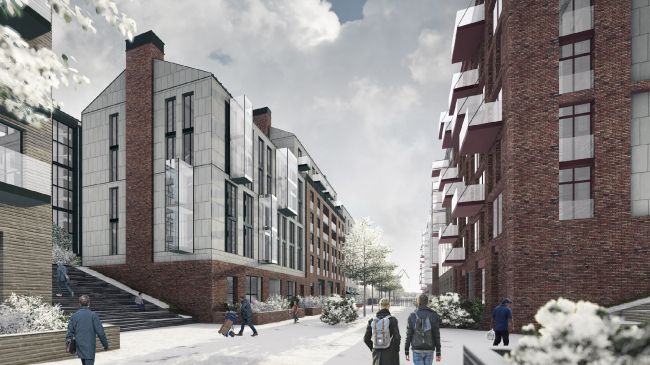|
Published on Archi.ru (https://archi.ru) |
|
| 30.09.2021 | |
|
Analysis and Synthesis |
|
|
Julia Tarabarina |
|
| Architect: | |
| Nikita Yavein | |
| Studio: | |
| Company: | |
|
The project of the housing complex “Krasin”, designed for the historical center of St. Petersburg, and situated in a very obliging place – next to the Mining University designed by Voronikhin, yet bordering on an industrial area – became the result of a thorough analysis of the specifics of historical construction on the Vasilyevsky Island, and a subsequent synthesis with avoidance of direct stylization, yet forming a recognizable silhouette, resonant with the “old town”. The embankment of the Big Neva of the Vasilyevsky Island is a place that is very quickly changing its character: in the east part, it starts with Strelka, Stock Exchange, Kunstkamera the old building of the University, and other famous tourist attractions. Then it continues with the Academy of Arts, an exquisite building designed by Vallain Delamont. And it ends with the Dorian portico of the Mining University, an austere, almost harsh statement in the pure dialect of classicism. However, this is where it all ends – the industrial area begins with a port area and ships in the distance. The city of museums and monuments abruptly gives way to a few constructivist buildings, which back in their days were built to cater for the factories. West of the Mining University, starts the territory of the Baltic Shipyard and a few factories of a smaller scale: ropes, leather, and electrical appliances. Here, on the Neva, one can even now see two atomic icebreakers, Siberia and Urals. “Krasin” housing complex. Left: Krasin Icebreaker. Right: the mining UniversityCopyright: © Studio 44The housing complex “Krasin”, named after the icebreaker, which has now been turned into a museum, moored directly in front of it, is located on the territory of the former boiler design bureau, which moved in 2018. Historically, this place is known as “Maslyany Buyan” (“Buyan”, a dated Russian word, was a moor for unloading cargoes, and a place where warehouses were situated). As early as in the 1940s, it became an artificial island, separated from the mainland by the Maslyany Channel, which the ships could enter for loading and unloading, and where they subsequently moored like in a bay. By the 1960s, the canal was filled up, but the surrounding area on both sides of the street is named “Oil Channel”. 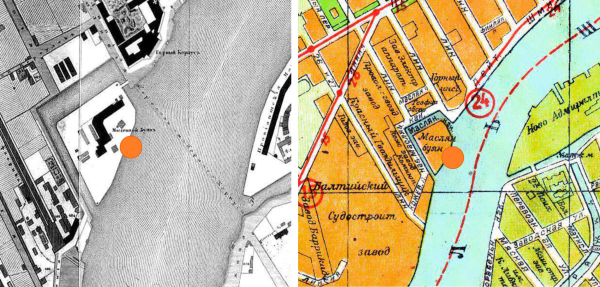 “Krasin” housing complex. Detailed plan of St. Petersburg by Major General Schubert 1828, plan of Leningrad 1934Copyright: © Studio 44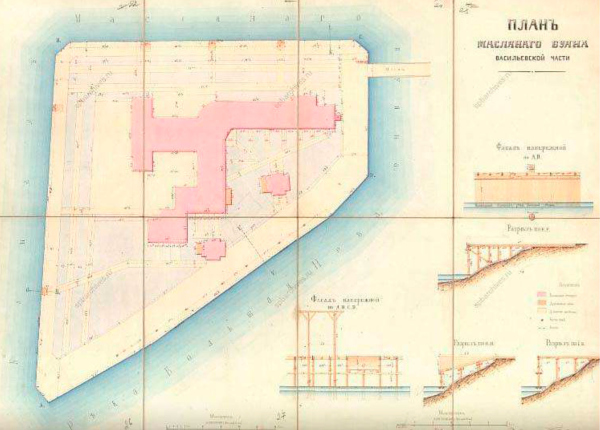 “Krasin” housing complex. Plan of “Maslyany Buyan” in its Vasilevsky Island part, 1876Copyright: © Studio 44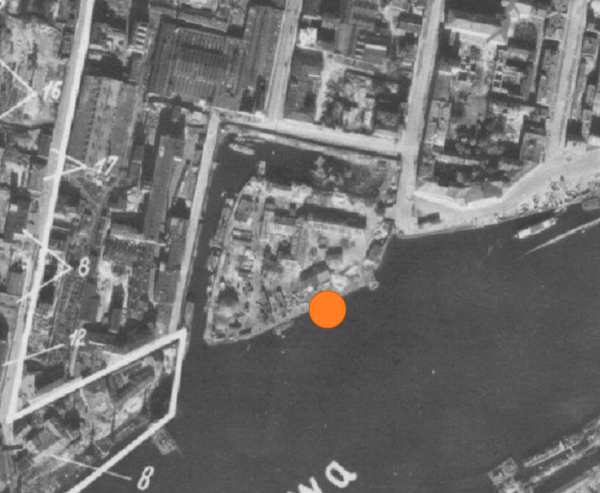 “Krasin” housing complex. The Oil Channel, Luftwaffe footage, 1942Copyright: © Studio 44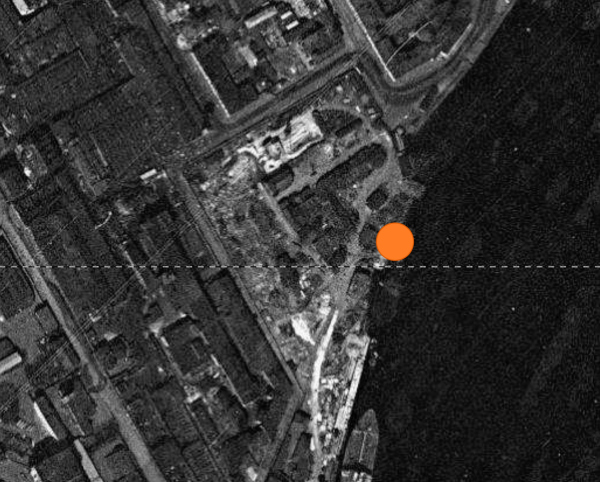 “Krasin” housing complex. A photograph made by an American satelliteCopyright: © Studio 44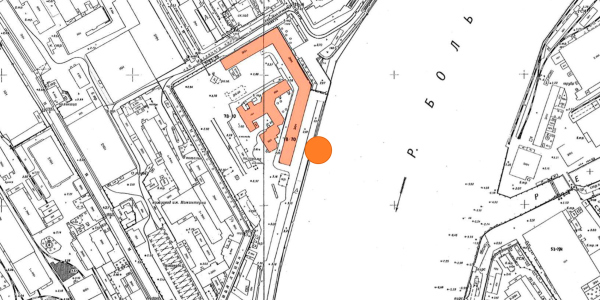 “Krasin” housing complex. Topographic plan of Leningrad, a fragment, 1977Copyright: © Studio 44 “Krasin” housing complex. Topographic plan of Leningrad, a fragment, 1989Copyright: © Studio 44The surroundings, as was already said, are contrastive and valuable, albeit in different ways. The ice breaker and the portico of the Mining University work together to create the classic “St. Petersburg tourist attraction” theme, making it necessary for the new buildings to be a little bit uptight, and, of course, it was the Voronikhin building that became the reason for the height restrictions – 22m close to it, 33m a little bit further away from it. In addition, the site is situated within the limits of the “historical settlement”, and the complex will be plainly visible from the Neva, which makes the height restrictions particularly strict: hence the pitched roofs with a 25-degree tilt, the decrease of the height towards the river, a moderate tone of the facades, and natural-looking textures of brick and stone. “Krasin” housing complexCopyright: © Studio 44Other elements of the context are not as obvious, but also important. These are the Paramonov Leather Factory, located in the west, on the opposite side of the Maslyany Kanal Street, and the late 19-century buildings in the spirit of industrial historicism of the classic nature – there are plans that these will host a health center and a school; nearby in the north there will probably be still another block of the housing complex. “Krasin” housing complexCopyright: © Studio 44The Maslyany Kanal Street makes a right-angle turn to the right, and one can see here yet another landmark – the water tower of the rope shop, built by Yakov Chernikhov, an elegant urban accent on slender concrete legs. “Krasin” housing complexCopyright: © Studio 44In addition, the residential buildings of Vasilievsky Island, situated to the east and north, provide an example of a restrained and diverse development front, ranging from classicism to historicism to modernism, while factory buildings of the 19th century to the west show an inclination towards the red-brick style of facades. As for the territory of the Maslyany Buyan itself, it was built up in the late Soviet era with three dull factory buildings, one of which was leased out for offices in recent years. “Krasin” housing complex. Icebreaker “Krasin” (0), entrance to the Sea Canal (MK), hull-processing shop (1), mechanical shop (2), slipway A, large (3), independent thermoelectric power station “Akademik Lomonosov” on completiCopyright: © Studio 44Thus, it comes as no surprise that the work for such an obliging place was preceded by a serious urban planning analysis – first of all, it covered the place of the new complex as part of the hippodamus grid of the streets of Vasilievsky Island. As is known, it is clear and simple, consisting of rather large rectangles: back in the day, Trezzini proposed a grid of streets with a cell 320 meters wide. Then finer fracturing came about, and the space between the streets stretching from northwest to southeast is now 160 meters. Historically, however, inside some of the quarters, there was a longitudinal internal passage, dividing the block into parts longitudinally (and sometimes transversely) – this is how the narrowest street in the city, Repin Street, appeared. If we take into account such cases and divide the cell in half by meridian, the cell width is already close to the “Manhattan” type: 80 meters.  “Krasin” housing complex. Project plan of Vasilievsky Island Domenico Trezzini 1717Copyright: © Studio 44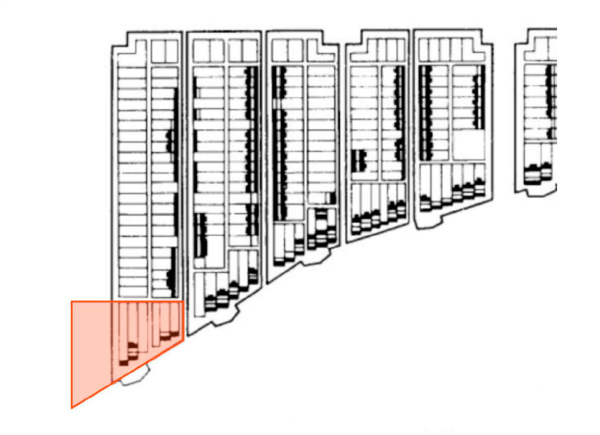 “Krasin” housing complex. Development of Vasilievsky Island according to the fixing plan. Fragment of the plan of 1726Copyright: © Studio 44The architects also take into account this division, which historically existed in an unmanifested form, but is read in the intra-quarter voids, and is supported by the peculiar numbering of the streets: on Vasilievsky Island, they do not count the driveways as such, but the lines of houses, so each street has a “paired” name, for example, “Lines 4 and 5”. The street that leads to Maslyany Buyan is “Lines 24 and 25”.  “Krasin” housing complex. Map of valuable elements of the planning and landscape-compositional structureCopyright: © Studio 44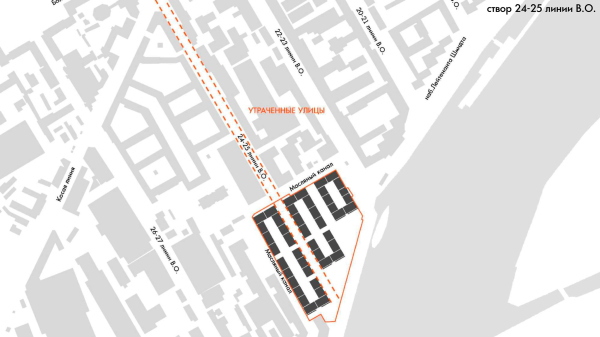 “Krasin” housing complex. Line 24-25 of Vasilyevsky IslandCopyright: © Studio 44The architects took the most fractional division module as a basis – the site was divided into three equal strips with two internal streets, one of which continues the line “24 and 25”. Currently, Lines 24 and 25 stop in a dead end in front of the Maslyany Canal Street – in the project it is planned to extend it to the embankment with a pedestrian promenade running inside the housing complex, although, according to the developer’s decision, it will, unfortunately, be open only to its residents. However, it will create, nevertheless, a promising passage. 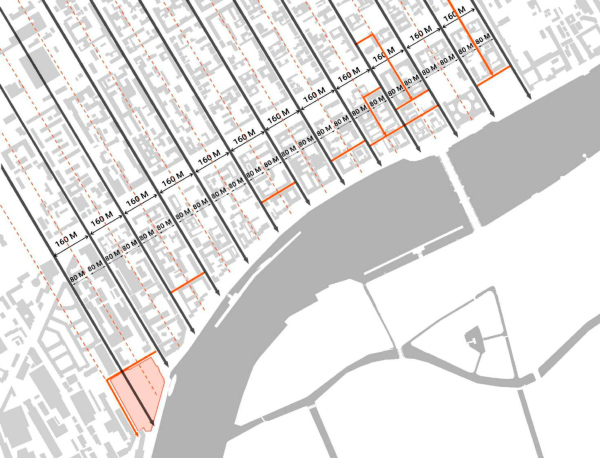 “Krasin” housing complex. Preserved in the present time internal passages and meridional connectionsCopyright: © Studio 44 “Krasin” housing complex. The streets and the inner passagesCopyright: © Studio 44The result is compact 4 and 6-story city blocks, subjugated to the grid of Vasilievsky Island and at the same time drawn more regularly, with thin extended frames. The Neva makes a turn here, and the rectangles systematically grow in an arc, not following the curve of the embankment, but protruding forward in “angle” steps. The authors “spied” this planning technique on the neighboring embankment of the 18th-19th centuries, where all the facades are parallel to the direction of the avenues of Vasilievsky Island, and are thus inscribed in a common orthogonal grid. In front of the arc of the river, they form “angle” steps. “Krasin” housing complex. The forming of new city blocksCopyright: © Studio 44Lieutenant Schmidt Embankment to the east of the Krasin housing complexCopyright: © Studio 44In the Krasin residential complex, this “step-like” character of the plan is more pronounced from the side of the waterfront: while in the historical front the zigzag contour is formed by the facades of individual houses, here it is formed by the ends of the city blocks, two sections in each. From the side of the river, triangular plazas are formed between them – this architectural gesture as a whole becomes more monumental, the juxtaposition of geometric angles and the smooth river bend becomes a contrast between man-made and natural, showing one of the characteristic features of St. Petersburg. “Krasin” housing complex. The project proposalCopyright: © Studio 44The indentations of the side ends of the city blocks are also uniform in the spirit of the “megalithic” attitude to volumes, typical of Nikita Yavein’s projects. Each end receives a continuation in the front of the neighboring block in the form of narrow, as if cut with a knife, gaps – they support the transverse direction of the grid and provide laconic caesuras, making it possible to avoid excessively long rows, at the same time opening passages to the courtyards. “Krasin” housing complexCopyright: © Studio 44“Krasin” housing complexCopyright: © Studio 44Thus, it turns out that at the level of general outlines of volumetric construction, the ideas were discovered by the architects in the historical development of Vasilyevsky Island – taken as a basis, but brought to a certain stereometric denominator, and thereby sharpened and strengthened. This approach to the context is particularly interesting because of its analytical nature. As for the facades, the opposite process takes place – while the volumes as a whole tend to regularity and enlargement, the facades are made deliberately fragmented, enlivened by a variety of textures, materials and geometry. Each section – 44 in total – received its own pattern and height, slightly different from the neighboring ones, which resulted in slight fluctuations in the silhouette. The parameters of all the sections were also the result of an analysis of the building structure of Vasilievsky Island, primarily its waterfront. 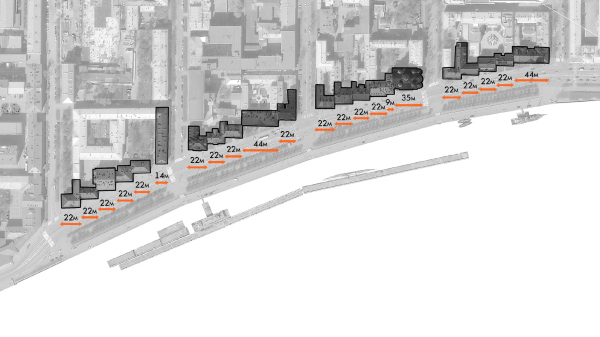 “Krasin” housing complex. The current parcellationCopyright: © Studio 44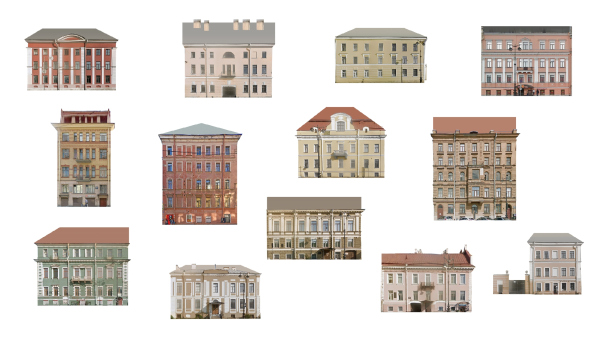 “Krasin” housing complex. The current stateCopyright: © Studio 44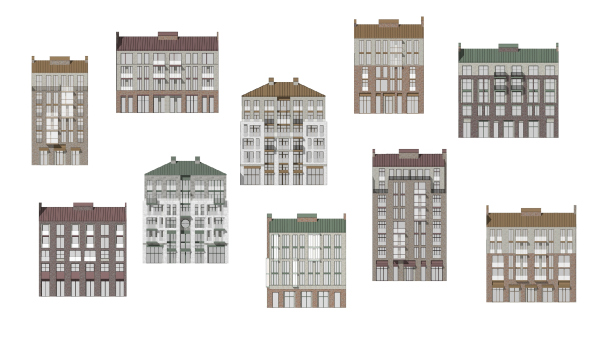 “Krasin” housing complex. The project proposal.Copyright: © Studio 44Therefore, the width of most of the sections is like that of the historical facades along the river, which ie 22 meters. From the rear side of the complex, this figure doubles up to 50 m – but no more than that. Here, the side-end houses are crowned with colonnades of attics, which is why they acquire greater monumentality, building on this side a semblance (or, perhaps, a “seed”) of an avenue. “Krasin” housing complexCopyright: © Studio 44“Krasin” housing complexCopyright: © Studio 44The facades pick up the rhythm and scale of the old buildings, but completely exclude direct quotes from the decor of historical architecture, focusing on rhythm, proportions, texture and tone. From the side of the Mining University and the regular historical city, where the altitude is lower, stone and light colors prevail. From the opposite side, from the west, as well as from the north, where the complex borders on industrial buildings and grows in height, there are more dark bricks. The complex responds with facades to almost all of its neighbors. “Krasin” housing complexCopyright: © Studio 44“Krasin” housing complexCopyright: © Studio 44Closer to the water tower designed by the avant-garde architect Yakov Chernikhov, the role of round windows, characteristic of the architecture of the 1920s-1930s and, in addition, loved by Nikita Yavein, becomes more noticeable (he considers it necessary to add at least one round window to each of his projects; such a window is also to be seen in the architect’s study). “Krasin” housing complexCopyright: © Studio 44On the facades, the “multilayered” method is actively used: one material, for example a brick, is treated as a large external “grid”, another, for example a stone, as the internal matter. Glass livens up the traditional materials with protrusions of balconies and bay windows, thin fences and plastic “sightseeing” cylinders at the corners – but in general the glass is not really abundant, there is even a diagram in the design materials that clearly demonstrates the predominance of “stone” surfaces. “Krasin” housing complexCopyright: © Studio 44“Krasin” housing complexCopyright: © Studio 44On the other hand, the architects are not using painted stucco at all here – which is a little bit counterintuitive because this is the “signature” facade material for the Vasilyevsky Island. This makes it possible to avoid garishness and enhance the respectability – for a modern housing complex in the center of the city, “natural facade materials” are definitely a plus. If historical details are ethically prohibited for architects, then the historical silhouette, on the contrary, is quite the right thing to do. In addition to the slight variability of the height of the sections and pitched roofs, ventilation outlets, designed in the form of plates resembling groups of chimneys, and in some cases placed on the sidewalls we and sharply reminiscent of fireplaces, work to make the silhouette of the “old city” recognizable. The yards inside the city blocks are elevated to the stylobate floors. From the street, they can be accessed by monumental staircases with amphitheaters. “Krasin” housing complexCopyright: © Studio 44The city gallery stretches along the western facade of the complex along Maslyany Canal Street in front of a continuous line of shops: it expands the sidewalk, allowing you to walk past the shop windows and hide from the rain. At the same time, it partially makes up for the residents-only status of the inner streets of the complex – you can easily walk past it to the Lieutenant Schmidt embankment. Underneath each of the blocks, there is a tier of underground parking, combined with storage rooms for the residents. Beneath the courtyard, there is another level of parking, the overland one. The spaces located at the city level are complex and, of course, not all of them are occupied by parking lots: many cafes and shops are planned along the outer perimeter of the buildings, and some of the premises under the courtyards within the city blocks are given to fitness facilities with two swimming pools, one of them, of a larger size, being illuminated by large beautiful skylights from the yard. Thus, despite the fact that the inner streets of the complex will only be accessible to the residents, the complex will still give the city a lot. 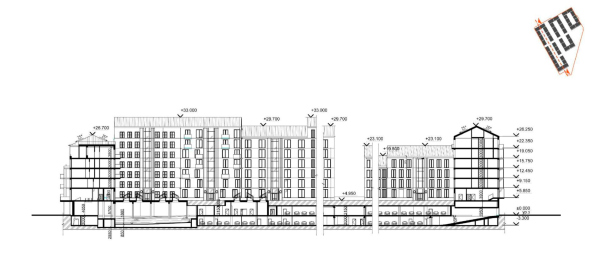 “Krasin” housing complex. Section View 3-3Copyright: © Studio 44 “Krasin” housing complex. Section View 2-2Copyright: © Studio 44 “Krasin” housing complex. Section ViewCopyright: © Studio 44 “Krasin” housing complex, Section View A-ACopyright: © Studio 44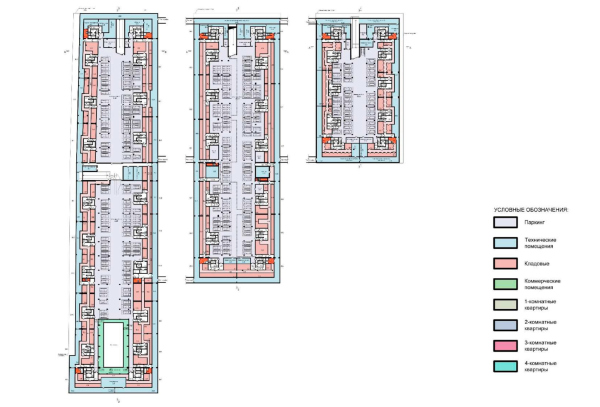 “Krasin” housing complex. Plan of the basementCopyright: © Studio 44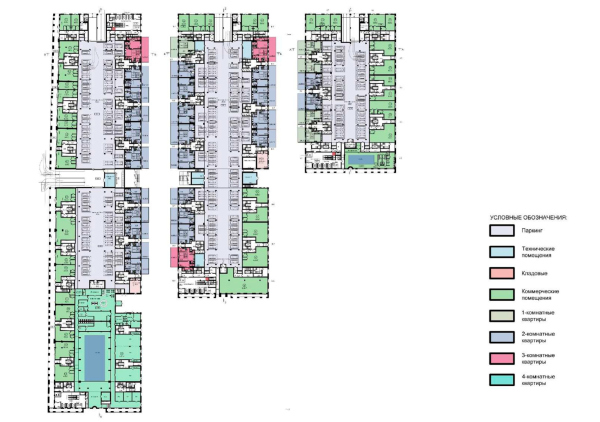 “Krasin” housing complex. Plan of the 1st floorCopyright: © Studio 44On the first floors there are apartments with their own front gardens facing the inner boulevards. The complex is quite expensive (this is how the press describes it, and its location and low altitude oblige it to a “closed-door” format), so its apartment layout is pretty diverse – there are three- and four-room apartments – the latter are grouped mainly at the corners with sweeping views of the Neva. 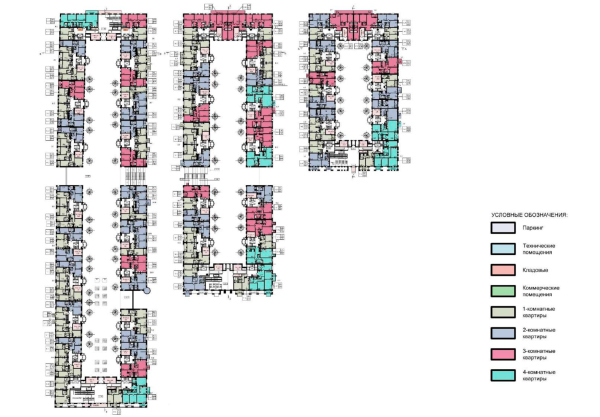 “Krasin” housing complex. Plan of the 2nd floorCopyright: © Studio 44 “Krasin” housing complex. Plan of the standard floorCopyright: © Studio 44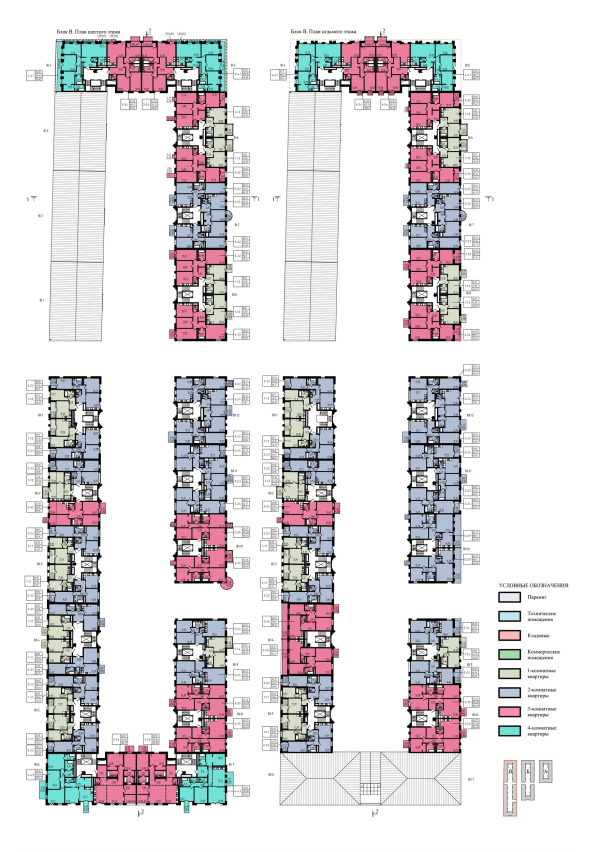 “Krasin” housing complex. Plan of the 7th floorCopyright: © Studio 44As we can see, this premium class residential complex in the center of St. Petersburg is the result of thoughtful analytical work with the context – in addition to responding to the visual features of the environment, it is tuned in to the continuation and development of the structure of the urban fabric, dating back to the regular planning of the 18th century. Some of its features are deliberately enhanced and exaggerated for the sake of responding to the features of the site and the task at hand. A small, comfortable height is due to the height restrictions and is supported by the high-end status of the project. The emphasized rhythmic diversity becomes a response to the fine cut of the facades of historical buildings. Ultimately, the complex becomes a kind of “transitional link” between two very different parts of the city: historical center and the industrial area. The port cranes and ships, both museum and under construction, add some piquancy to the atmosphere; the residential complex is becoming the next step in the urban fabric, comfortable and inhabited, a step towards expansion and replication based on the module once set by Trezzini and Leblond. |
|
